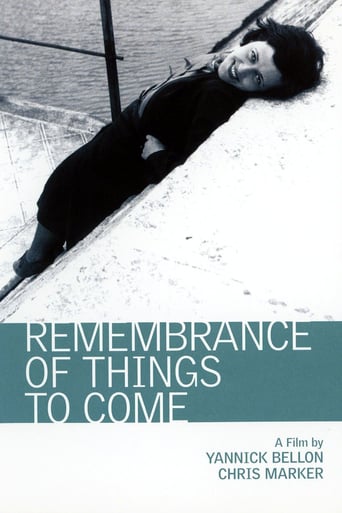debblyst
Cinema's greatest essayist-artist Chris Marker pays homage to French photographer Denise Bellon (1902-1999) by making an incredibly beautiful, insightful montage of her photos of the 1930s and 1940s to show how the "great illusion" of post-WWI European peace gradually deteriorated into the horrors of WWII. Co-directed by Bellon's filmmaker daughter Yannick, "Le Souvenir d'un Avenir" combines Bellon's breathtaking images, Marker's nec plus ultra insightful/knowledgeable/poetic/ironic commentary (narrated by Pierre Arditi in the French version and by Alexandra Stewart in the English version), and a montage that can only be compared to great music.Linked to the Surrealist movement and the legendary generation of photographers who worked (as she did) for the Alliance Photo Agency, Bellon showed through her images the signs of the ponderous, eerie calm preceding the big storm. Marker ingeniously reveals the links between apparently "innocent" images and the appalling realities that lay underneath -- the 1930s cult of calisthenics and physical health that indicated the Nazi (and Scandinavian, let's not forget it) theories of racial superiority and the Soviet cult of the strong proletariat; the formal and ideological clash between French and Soviet art at the Paris' World Fair of 1937; her photo of a gypsy bride on the cover of a 1939 Paris Match issue that also (and incredibly) included excerpts of "Mein Kampf" in which Hitler called gypsies and other "low" ethnicities "half-simian". Like Marker throughout his own career, Bellon showed exceptional sensibility, intuitiveness and intelligence in being at dangerous spots in critical times: one moment she's in the then French colonies of Morocco and Tunisia, photographing the slave-like training of natives as future war troopers (the expendables ones) and the bordellos recruiting Tunisian women for the "repos" of the French military; then, she's at the German maneuvers in Finland that experimented with the heavy weaponry and war strategies soon to ensue; then she's at the Aran Valley in Spain, documenting the little-known, ill-fated uprising by Spanish Republicans against dictator Franco; then, in Paris, documenting the influx of French "ploucs" that initiated the policy of using (and abusing) low-class and immigrant labor force. But "Le Souvenir d'un Avenir" is not a film-à-thèse: its political, cultural and sociological insights are just as historically sound as they are the product of Marker's superior and very personal sensibility and vision. It's also very moving, as there are many pictures of Bellon's two daughters (filmmaker Yannick and actress Loleh) in various phases of childhood and adolescence, against the changing backdrop of post-war France.Made when he was at the age of 80(!), Marker's masterful art of transforming historical research into revelatory interpretation using images, words and sounds shows no signs of fatigue, and "Le Souvenir d'un Avenir" is the undebatable proof: it's probably his best since the masterpiece "Sans Soleil".
julianorj
Nice movie.Although the shadow of the World Wars may be overstressed in the film, Marker can sometimes suddenly bring some unexpected lightness to the film bringing her children photo.It's interesting how a movie made only by stills and voice over (and little music) can be that incisive. Marker is a master at that.The duration (about 40') is very precise. Before it starts to bore us it ends.The text is so strong that sometimes you kinda forget that these are not MArker's images. When he talks about the photographer Denise Bellon (all the images of the film are hers) you realize that you were kind of far away in the trip throughout the 20th century that the movie makes us get into, and you look at these images with some distance again.
